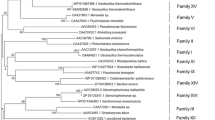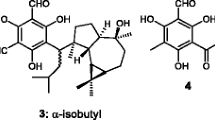Abstract
We have previously cloned and sequenced three members of a bile acid-inducible gene family from Eubacterium sp. strain VPI 12708 that encode 27,000-M r polypeptides. Two copies of these genes (baiA1 and baiA3) are identical, while the third copy (baiA2) encodes a polypeptide sharing 92% amino acid identity with the baiA1 and baiA3 gene products. We have overexpressed the baiA1 gene in Escherichia coli and analyzed the expressed activity. Thin-layer chromatography of 14C-labeled bile acid products from reactions using cell-free extracts revealed a 3α-hydroxysteroid dehydrogenase activity for the BaiA1 protein. The BaiA1 protein could utilize both NAD+ and NADP+, and the preferred steroid substrate was the cholyl-coenzyme A conjugate rather than free cholic acid. These results show that the BaiA proteins are novel 3α-hydroxysteroid dehydrogenases.
Similar content being viewed by others
Literature Cited
Baron SF, Franklund CV, Hylemon PB (1991) Cloning, sequencing, and expression of the gene coding for bile acid 7α-hydroxysteroid dehydrogenase from Eubacterium sp. strain VPI 12708. J Bacteriol 173:4558–4569
Bradford M (1976) A rapid and sensitive method for the quantitation of microgram quantities of protein utilizing the principle of protein-dye binding. Anal Biochem 72:248–254
Chen Z, Lu L, Shirley M, Lee WR, Chang SH (1990) Site-directed mutagenesis of glycine-14 and two “critical” cysteinyl residues in Drosophila alcohol dehydrogenase. Biochemistry 29:1112–1118
Chen Z, Jiang JC, Lin Z-G, Lee WR, Baker ME, Chang SH (1993) Site-specific mutagenesis of Drosophila alcohol dehydrogenase: evidence for involvement of tyrosine-152 and lysine-156 in catalysis. Biochemistry 32:3342–3346
Coleman JP, White WB, Egestad B, Sjövall J, Hylemon PB (1987a) Biosynthesis of a novel bile acid nucleotide and mechanism of 7α-dehydroxylation by an intestinal Eubacterium species. J Biol Chem 262:4701–4707
Coleman JP, White WB, Hylemon PB (1987b) Molecular cloning of bile acid 7-dehydroxylase from Eubacterium sp. strain VPI 12708. J Bacteriol 169:1516–1521
Coleman JP, White WB, Lijewski M, Hylemon PB (1988) Nucleotide sequence and regulation of a gene involved in bile acid 7-dehydroxylation by Eubacterium sp. strain VPI 12708. J Bacteriol 170:2070–2077
Eneroth P (1963) Thin-layer chromatography of bile acids. J Lipid Res 4:11–16
Franklund CV, de Prada P, Hylemon PB (1990) Purification and characterization of a microbial, NADP-dependent bile acid 7α-hydroxysteroid dehydrogenase. J Biol Chem 265:9842–9849
Franklund CV, Baron SF, Hylemon PB (1993) Characterization of the baiH gene encoding a bile acid-inducible NADH: flavin oxidoreductase from Eubacterium sp. strain VPI 12708. J Bacteriol 175:3002–3012
Ghosh D, Weeks CM, Grochulski P, Duax WL, Erman M, Rimsay RL, Orr JC (1991) Three-dimensional structure of holo 3α,20β-hydroxysteroid dehydrogenase: a member of a short-chain dehydrogenase family. Proc Natl Acad Sci USA 88:10064–10068
Gopal-Srivastava R, Mallonee DH, White WB, Hylemon PB (1990) Multiple copies of a bile acid-inducible gene in Eubacterium sp. strain VPI 12708. J Bacteriol 172:4420–4426
Hylemon PB, Melone PD, Franklund CV, Lund E, Björkhem I (1991) Mechanism of intestinal 7α-dehydroxylation of cholic acid: evidence that allo-deoxycholic acid is an inducible side-product. J Lipid Res 32:89–96
Mallonee DH, White WB, Hylemon PB (1990) Cloning and sequencing of a bile acid-inducible operon from Eubacterium sp. strain VPI 12708. J Bacteriol 172:7011–7019
Mallonee DH, Adams JL, Hylemon PB (1992) The bile acid-inducible baiB gene from Eubacterium sp. strain VPI 12708 encodes a bile acid-coenzyme A ligase. J Bacteriol 174:2065–2071
Matsubara Y, Kraus JP, Ozasa H, Glassberg R, Finocchiaro G, Ikeda Y, Mole J, Rosenberg LE, Tanaka K (1987) Molecular cloning and nucleotide sequence of cDNA encoding the entire precursor of rat liver medium chain acyl coenzyme A dehydrogenase. J Biol Chem 262:10104–10108
Neidle E, Hartnett C, Ornston LN, Bairoch A, Rekik M, Harayama S (1992) Cis-diol dehydrogenases encoded by the TOL pWW0 plasmid xylL gene and the Acinetobacter calcoaceticus chromosomal benD gene are members of the short-chain alcohol dehydrogenase superfamily. Eur J Biochem 204:113–120
Paone DAM, Hylemon PB (1984) HPLC purification and preparation of antibodies to cholic acid-inducible polypeptides from Eubacterium sp. VPI 12708. J Lipid Res 25:1343–1349
Persson B, Krook M, Jörnvall H (1991) Characteristics of short-chain dehydrogenases and related enzymes. Eur J Biochem 200:531–543
Roberts I, Hylemon PB, Holmes WM (1991) Rapid method for altering bacterial ribosome-binding sequences for overexpression of proteins in Escherichia coli. Protein Expr Purif 2:117–121
White BA, Lipsky RL, Fricke RJ, Hylemon PB (1980) Bile acid induction specificity of 7α-dehydroxylase activity in an intestinal Eubacterium species. Steroids 35:103–109
White BA, Cacciapuoti AF, Fricke RJ, Whitehead TR, Mosbach EH, Hylemon PB (1981) Cofactor requirements for 7α-dehydroxylation of cholic and chenodeoxycholic acid in cell extracts of the intestinal anaerobic bacterium, Eubacterium species V.P.I. 12708. J Lipid Res 22:891–898
White WB, Coleman JP, Hylemon PB (1988a) Molecular cloning of a gene encoding a 45,000-dalton polypeptide associated with bile acid 7-dehydroxylation in Eubacterium sp. strain VPI 12708. J Bacteriol 170:611–616
White WB, Franklund CV, Coleman JP, Hylemon PB (1988b) Evidence for a multigene family involved in bile acid 7-dehydroxylation in Eubacterium sp. strain VPI 12708. J Bacteriol 170:4555–4561
Yoshimoto T, Higashi H, Kanatani A, Lin XS, Nagai H, Oyama H, Kurazono K, Tsuru D (1991) Cloning and sequencing of the 7α-hydroxysteroid dehydrogenase gene from Escherichia coli HB101 and characterization of the expressed enzyme. J Bacteriol 173:2173–2179
Author information
Authors and Affiliations
Rights and permissions
About this article
Cite this article
Mallonee, D.H., Lijewski, M.A. & Hylemon, P.B. Expression in Escherichia coli and characterization of a bile acid-inducible 3α-hydroxysteroid dehydrogenase from Eubacterium sp. strain VPI 12708. Current Microbiology 30, 259–263 (1995). https://doi.org/10.1007/BF00295498
Issue Date:
DOI: https://doi.org/10.1007/BF00295498




